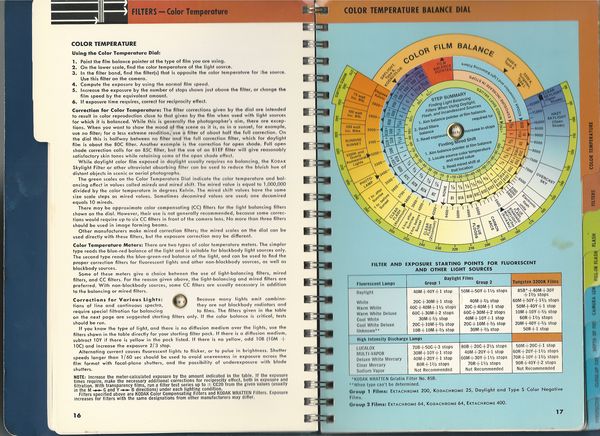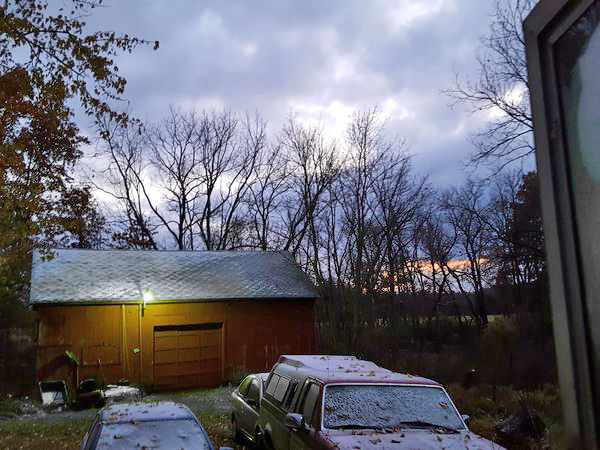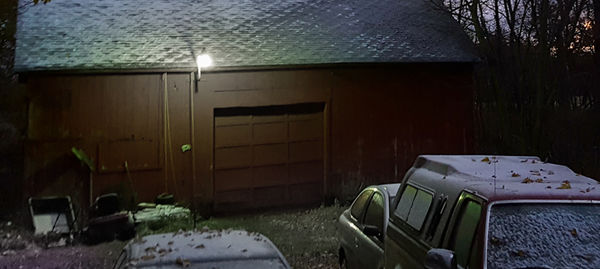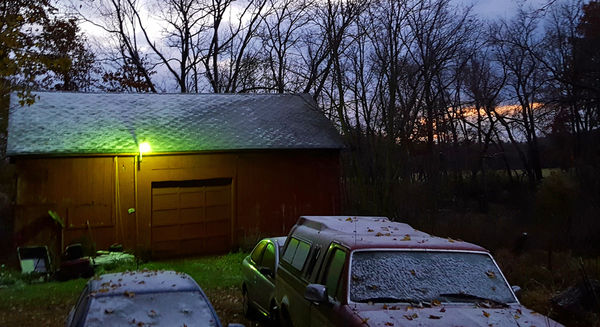Why do barn lights and other lights look green?
Nov 30, 2018 11:04:49 #
Sodium vapor lamps have two emission lines that average to 589 nm, which is the orange end of yellow. Green is less than 570 nm. Could the glass bowl surrounding the lamp be greenish. One fine mystery.
Nov 30, 2018 11:13:24 #
larryepage
Loc: North Texas area
JohnSwanda wrote:
The WB is fine. The light really is green. Correcting to make the light neutral would throw off the WB for the rest of the photo.
The mercury vapor lamp is not providing the primary illumination in this photo. For that reason, I'd not change the WB.
But in order to fix the problem with white balance adjustments when the mercury lamp does provide the primary illumination, it will be necessary to not only adjust the yellow/blue axis (normal emission scale adjustments) it will be necessary to make adjustments on the secondary yellow/violet (or sometimes yellow magenta or yellow/cyan) axis. I do this on my cameras by rotating the sub-command dial when in the Kelvin position. It is important to note that WB adjustments are not a pure single-primary color ange like adjusting pure pigments or primary (RGB) light sources, but adjust a single primary color against its complement or something close to its complement.
Nov 30, 2018 11:26:06 #
Sounds to me, there is nothing that can be done to change the color of the light, Green is Green, Your White Balance is correct, so what do you want from us here at UHH??
Nov 30, 2018 11:45:07 #
Silverman wrote:
Sounds to me, there is nothing that can be done to change the color of the light, Green is Green, Your White Balance is correct, so what do you want from us here at UHH??
It could be changed locally, by several means. See my post above for doing it with the clone tool.
Nov 30, 2018 12:27:56 #
Nuts and bolts.
Attached, is a reproduction of the "filter" dial out of my old Kodak Pro Photo Guide. Although it pertains to film, it gives you the concept of color temperature, spectrum and filtration. Back in the film era, color films were typed or categorized as to their color balance, usually for daylight or tungsten sources. Theses sources have continuous spectrums- all the color of the spectrum are there but in different quantities and proportions. Parts of the spectrum that were deficient for any particular color film could be somewhat replaced or changed by filtration.
Black body or tungsten lamps, in many lighting applications in offices, factories, stores, arenas and street lighting were being rapidly replaced (the name of more lumens per watt) by Fluorescent and High Intensity Discharge Lamps, which have basically discontinuous spectrums- certin colors are absent. More complex filter combinations were used to correct and balance for theses light sources. This was difficult work in that there were many lamps and tubes from different manufacturers that were in-between the standard types listed. Older lamps and tubes varied in color and mixed ligh was a nightmare. If, for example, an interior uniformly lighted with one kind of lamp could be corrected for, however, if people were or a certin objects was in the shot and required individual lighting or fill lighting, it had to be exactly the same source as the all over lighting. Certain fluorescent lamps "flickered" and required slower shutter speed for even exposures. This flickering and denser filter packs extended exposure times and reciprocity law failure kicked in and required yet more filtration.
So, my fellow Hogs, next time you see your latest digital camera, give it a big hug and a kiss, especially its auto and custom white balance features and thank the Universe that reciprocity law failure is ancient history. Newerer "electronic" fluorescent lamps without the old fashioned ballasts don't flicker anymore and more LED lighting is appearing in public places, factories and offices. With a little work, you could acheive a decent color balance for just about any light sourced and get more or less authentic color reproduction. You don't need to worry too much about the physics.
As for the OP's basic question- If you are balanced for daylight, a moonlit scene, a streetscape lighted by one particular source and there is one of those dirty old High Intensity Discharge lamps rearing its ugly head in the background or someplace, lighting up a barn, a building or a garden in the scene- you are gonna get those weird colors- green, purple, and a few that haven't been invented or discovered yet!
Sometimes, I just stop all the way down to f/22 or f/32, lengthen the exposure and the ugly lights turn into little stars of green and blue or wahtever!
Attached, is a reproduction of the "filter" dial out of my old Kodak Pro Photo Guide. Although it pertains to film, it gives you the concept of color temperature, spectrum and filtration. Back in the film era, color films were typed or categorized as to their color balance, usually for daylight or tungsten sources. Theses sources have continuous spectrums- all the color of the spectrum are there but in different quantities and proportions. Parts of the spectrum that were deficient for any particular color film could be somewhat replaced or changed by filtration.
Black body or tungsten lamps, in many lighting applications in offices, factories, stores, arenas and street lighting were being rapidly replaced (the name of more lumens per watt) by Fluorescent and High Intensity Discharge Lamps, which have basically discontinuous spectrums- certin colors are absent. More complex filter combinations were used to correct and balance for theses light sources. This was difficult work in that there were many lamps and tubes from different manufacturers that were in-between the standard types listed. Older lamps and tubes varied in color and mixed ligh was a nightmare. If, for example, an interior uniformly lighted with one kind of lamp could be corrected for, however, if people were or a certin objects was in the shot and required individual lighting or fill lighting, it had to be exactly the same source as the all over lighting. Certain fluorescent lamps "flickered" and required slower shutter speed for even exposures. This flickering and denser filter packs extended exposure times and reciprocity law failure kicked in and required yet more filtration.
So, my fellow Hogs, next time you see your latest digital camera, give it a big hug and a kiss, especially its auto and custom white balance features and thank the Universe that reciprocity law failure is ancient history. Newerer "electronic" fluorescent lamps without the old fashioned ballasts don't flicker anymore and more LED lighting is appearing in public places, factories and offices. With a little work, you could acheive a decent color balance for just about any light sourced and get more or less authentic color reproduction. You don't need to worry too much about the physics.
As for the OP's basic question- If you are balanced for daylight, a moonlit scene, a streetscape lighted by one particular source and there is one of those dirty old High Intensity Discharge lamps rearing its ugly head in the background or someplace, lighting up a barn, a building or a garden in the scene- you are gonna get those weird colors- green, purple, and a few that haven't been invented or discovered yet!
Sometimes, I just stop all the way down to f/22 or f/32, lengthen the exposure and the ugly lights turn into little stars of green and blue or wahtever!

Nov 30, 2018 15:50:36 #
BlueMorel wrote:
Here is a photo I took with my cellphone of twilight clouds over my barn. A barn light in the photo looks green, which I've run into before when I take night shots. Sodium arc lamp, BTW.
What causes this? Fixes?
What causes this? Fixes?
The lamps are green. Mercury vapor outdoor lamps that last for years are green. Mine finally burned out after 7 years of constant 24/7 use. No fix. They are what they are!
Nov 30, 2018 17:58:36 #
Amending reply. I had not thought about mercury vapor light. That is your green.
John_F wrote:
Sodium vapor lamps have two emission lines that average to 589 nm, which is the orange end of yellow. Green is less than 570 nm. Could the glass bowl surrounding the lamp be greenish. One fine mystery.
Nov 30, 2018 18:49:59 #
BlueMorel wrote:
Sodium arc lamp, BTW.
What causes this? Fixes?
Sodium arc lamp, BTW.
What causes this? Fixes?
Cause: That is the spectrum of sodium
and the other ingredients that are added
to it. It's not pure sodium, which would
be crazy orange-ish yellow.
Fix: Select area, feather selection, and
subtract green and/or add magenta, as
seen in example below.
Nov 30, 2018 23:34:32 #
E.L., That is an amazing response IMO. Such insight regarding the complexities involved in the use of film makes me have even more respect for “back in the film era” pro photographers. I shot film way back then too, but never came close to your level of knowledge. Very interesting read. Thanks!
[quote=E.L.. Shapiro]Nuts and bolts.
“Attached, is a reproduction of the "filter" dial out of my old Kodak Pro Photo Guide. Although it pertains to film, it gives you the concept of color temperature, spectrum and filtration. Back in the film era...”
[quote=E.L.. Shapiro]Nuts and bolts.
“Attached, is a reproduction of the "filter" dial out of my old Kodak Pro Photo Guide. Although it pertains to film, it gives you the concept of color temperature, spectrum and filtration. Back in the film era...”
Dec 1, 2018 03:58:28 #
pquiggle wrote:
Sodium arc lamps are yellow and mercury vapor lamp... (show quote)
As a Science nut, I agree your answer is a good one.... but this is not the time for science.... Science is Treason ... next you will use the words forbidden in Florida by the Bug Eyed Govenor... "Global Warming."
Often the human brain in real time rejects and adjusts things like color to be what is expected. Camera sensors are not linear being much more sensitive to green. Once on screen, our brain sees the green that was white adjusted for when viewing the reality. Also the brain focused on the shadows and not the exact color of the light... the shadows are where Sabertooth tigers may be lurking... primitive brain thing you know... like mrT.
" Each primary color does not receive an equal fraction of the total area because the human eye is more sensitive to green light than both red and blue light. Redundancy with green pixels produces an image which appears less noisy and has finer detail than could be accomplished if each color were treated equally"
https://www.cambridgeincolour.com/tutorials/camera-sensors.htm
Dec 1, 2018 06:46:49 #
BlueMorel wrote:
Here is a photo I took with my cellphone of twilight clouds over my barn. A barn light in the photo looks green, which I've run into before when I take night shots. Sodium arc lamp, BTW.
What causes this? Fixes?
What causes this? Fixes?
There is no camera on the planet that can accurately resolve two light sources with different spectra. The only way I know of to get consistent results is to do a dual illuminant color profile using an Xrite ColorChecker Passport.
You can come close using a radial filter in raw processing - where the software allows you to change the color of an area locally, like Lightroom/Photoshop, but it imprecise and pretty tedious if you have multiple lights.
Dec 2, 2018 08:58:53 #
Since you cannot change the green in photographing it you can always change it
in the post processing. Photoshop can do the work but it does take some
understanding to know how to use it.
in the post processing. Photoshop can do the work but it does take some
understanding to know how to use it.

Dec 2, 2018 15:53:45 #
Pixelmaster wrote:
Since you cannot change the green in photographing it you can always change it
in the post processing. Photoshop can do the work but it does take some
understanding to know how to use it.
in the post processing. Photoshop can do the work but it does take some
understanding to know how to use it.
Great job with PS. I like that you kept the barn color from going toward the blue side. I have PS but haven't worked with it.
If you want to reply, then register here. Registration is free and your account is created instantly, so you can post right away.









